WW1 in Alsace - Linge Battle - 63rd Anti Aircraft Regiment - 96th poste semi-fixed
From Fleurus to Sedan, the history of the French antiaircraft artillery from 1909 to 1939.
![]()
«"... We, Pierre Donat, observer at the tower of Maubeuge, and Jean-Marie Coutelle, the captain commanding the balloonists, wind from the North and strong enough, we have amounted to 8 o'clock in the morning. We were just at the height of 10 fathoms (43) a cannonball from the fortification has risen to a fairly great distance above the balloon, 20 or 30 fathoms above, a second from the same side spent as close to 50 squares around, a third has gone very close to us on the left (44) .... »
This first firing of austrian artillerymen, the 25 Prairial of the Year II (45) against the « Entreprenant », tethered balloon with 27 feet in diameter, is undoubtedly the anecdotal event announcing the birth of a new weapon : the antiaircraft artillery.
But it is from 1870 during the siege of Paris, when besieged citizen use free balloons to communicate with the province that the first specialized weapons will be built. The Prussians, infuriated by the passage of french balloons make urgently build by Krupp factories a « musket against balloons » (46)
Thus, the emergence of a threat from the sky was immediately followed by a terrestrial means of response.
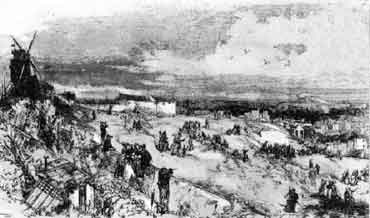 Postcard : the bombing of the city of Paris during the siege of 1870 - 1871
Postcard : the bombing of the city of Paris during the siege of 1870 - 1871
Thereafter, any gain in speed and altitude of the air force was quickly overtaken by increasing the effectiveness of the terrestrial means. Therefore, the evolution of the threat and its antidote are parallel. But they have not always been concurrent. The inadequacy of the French antiaircraft defence during the Battle of France in 1940 is an illustration of the time lag. Yet newborn at the beginning of the First World War, artillery to defend against plane, then against aircraft had experienced a boom and a fantastic efficiency until 1919. The magnitude of casualties of the Great War, the immensity of the reconstruction effort and the instability of the political
![]()
structure of this era will lead antiaircraft artillery, which succeed to the DCA, the fate described above, despite an upsurge in from 1935.
The adaptation of the anti-aircraft artillery, become ground-to-air artillery, the progress of the jet of air forces and the use of missile as a vehicle of its munitions will be developed in subsequent publications.
However, the use by the Prussians to the musket against balloon will not give rise to particular curiosity before 1900.
The craze for dirigible airships, the tethered balloons and aircraft, in the late nineteenth and early twentieth century, encourages artillerymen to seek ways to defend against aircraft. A note sent on April 22, 1900 the Minister of War « on a research program of the means to attack airships » by Lieutenant-Colonel St. Clair Deville (47) Director of the Technical Section of artillery, is the first document attesting to the interest of the French artillery for a weapon to defend
against a flying object.
Studies firing on aircraft are undertaken in 1904 under the leadership of the committee of Artillery and, in September 1906, the Engineering Section of artillery requests that experiments are carried out as soon as possible in order to define a hardware and a shell effective against aircraft (48). Gunshots are held next year at Camp Mailly with the 75mm gun model 1897 on field carriage and coastal carriage modified by the construction workshops of Bourges. These experiences show the inability of the 75mm field canon to meet the need because of the restriction of its firing range in destination and in site.(49)
On May 1st, 1908, the Board of Artillery is considering a proposal « 75mm gun on car » from the lieutenant colonel Sainte-Claire Deville, became director of the Lyon workshop. The carrying out of this project was entrusted to the Puteaux Workshop on June 6, 1908 by the Permanente Inspectorate of Artillery Fabrications.
This automotive equipment against balloon is ready in 1910 and submitted in October of that year during the fall war game at camp of Châlons with a range of other materials for the aircraft as firing against the guns of 37mm and 47mm, The 75mm gun on makeshift device and platform of Bourges or
![]()
carriage for vertical shooting machine guns. Some smoke and incendiary shells are also presented.
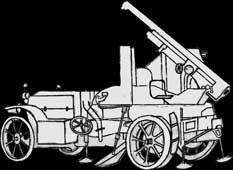
After firing experiments in Toulon and Calais, the project of car with gun is finally adopted in April 1913 and an order for 30 pieces went to the workshops in Puteaux. The car with 75mm gun is mounted on a platform consisting of a car « De Dion Bouton. » If the first gun designed specifically for the anti-aircraft firing a gun is « automobile » is that in the minds of designers, it must, after firing a first shot, being able if necessary to move on to the road to pursue the aircraft.
This design is audacious even though idealistic, even if speeds of balloons and aircraft of the day were between 20
and 60 km / h. The execution of this order is long and, in July 1914, the French artillery has only one copy of car with gun and some fixed platforms allowing the firing of 75mm gun up to an angle of site 40 degrees.
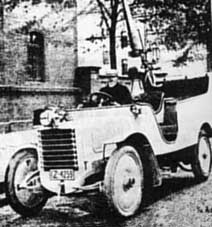
© La vie automobile
![]()
Germany, despite the experience of 1870, is hardly more advanced, although the emperor had ordered, in 1904, studies in this field. The anti-aircraft guns mounted on automobiles are presented during auto shows in Berlin between 1906 and 1909 without immediate succession.
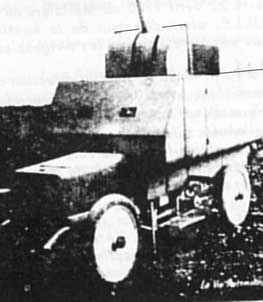
© La vie automobile
THE GREAT WAR
THE SITUATION AT BEGINNING OF CONFLICT
In the early twentieth century, airships and aircraft have aroused great interest in military circles. So when the conflict broke parks aeronautical adversaries are important.
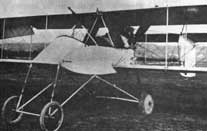
![]()
In addition, there is a not inconsiderable number of tethered balloons. But beyond the numbers, it should be noted a difference in employment doctrine on both sides of the front. While in France, the use of these aircraft is intended only for the recognition, Germany, their use for the bombing is expected early in the war. Thus, on August 3, 1914, a German plane dropped six bombs on Lunéville.
On August 30, a « Taube » drops five bombs on Paris. Ahead the small number of specialized equipment and the absence of a method of shooting anti aircraft, artillery officers use the 75mm field gun and individual weapons by « shootings. » These interventions are ineffective although one of them was fatal to Zeppelin VII shot down August 23 at Badonvillers by a 75mm field gun set battery on a makeshift carriage.
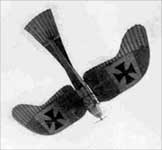
During the first months of the conflict, at the hands of this new threat, the artillerymen give free rein to their inventive spirit : guns are mounted on trees or on the trailer for munition, circulars pointing or makeshift platforms are built. But these extremely varied devices have a common character : they are destructive for the 75mm gun which brake is not designed for such great angles site.
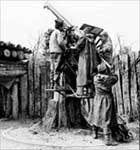
These improvisations have another unfortunate result. As soon as the troops saw a dirigible airship, they opened fire without concern for prior identification. Thus, the dirigible airship « Fleurus » is severely damaged by a quick fire of French infantry weapons. Since October 1914, this type of shooting is forbidden and artillerymen remain alone in combat aircraft. Soon after the stabilization of the front, specialization, begins in the artillery.
![]()
THE ORGANIZATION FROM 1914 TO 1918
The endowment specialized equipment is non-existent at the beginning of the conflict. When the first anti-aircraft guns come to armies, guns or troops of two guns are attached to different organizations that have no link between them (50).
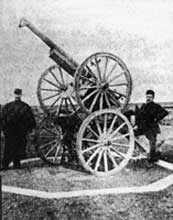
Relatively quickly, defend against aircraft, DCA, will be grouped into two major groups: the DCA Defence camp of Paris and the DCA to armies. Later, a third set is added to the firsts : the inside DCA grouping the posts and troops defending few vital centers as Le Havre, Orleans, Bourges, Lyon, Le Creusot, ...
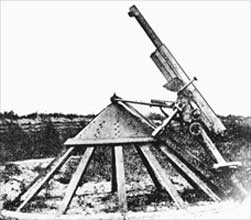
![]()
Starting from November 1915, the shooting posts are gathered in groups of 5 or 6, which will make up the future batteries.
It is the year 1916 which actually marks the birth of the aircraft artillery. In January 1916, the creation of a technical inspection of the defense against plane to armies in the Inspectorate of artillery equipment to the armed forces is decided on and put under the command General Sainte-Claire Deville.
On February 1, 1916, the Centre for shooting against aircraft of Arnouville-les-Gonesse, and the commission studying practices shooting against aerial targets are grouped into a single organization. The squadron leader (51) Pagezy is the first head of this unit..
Finally, on 1 August, the incorporation of all units of car with gun and posts and semi-fixed DCA to the 62nd Artillery Regiment of Saint-Cloud is ordered and realized.
On September 12, 1916, a regulation document, « The direction and organization of the defense against plane, » says the « new » organization meaning the outcome of the decisions described in the preceding paragraph.
«... The defense against aircraft includes :
![]()
four successive lines of surveillance posts.
In early 1917, the emergence in western front of « german heavy bombers » (for the time) such as « Gothas » and « Friedrichshafen » requires close collaboration of all means of defense against airplane It is important to coordinate all means of action of the armies (French and British armies), as well as those of the Navy and Defense of the Interior in order to obtain maximum performance.
A council of air defense of the territory was created in July 1917. From the first meeting, it appears that the coordination of air defenses in the french armies and among allied armies can be done only at levels of command extremely high. Therefore, the Military Staff General is responsible. The General Foch, head published on August 13, 1917 a new plan for air defense, which remains in force until the end of the war.
Allocation of charge and missions is more detailed than in the previous plan. Thus, the air defense of the territory is ensured by a combination of the defence system of the armies and civil defence.
« ... The defence comprises :
In May 1918, the resources allocated to the armed forces are increasing and that is why the 63rd Artillery Regiment (53), in which they are grouped, is divided into three specialized regiments : the 66th with 75mm gun on car and troops of 75mm gun on trailer, the 166th, administratively attached to the first, with units with 105mm gun on platforms
![]()
semi-fixed and the 67th with the units of projectors.
THE MATERIALS MEANS
Compared to the need, the arrival of the equipment is slow at the beginning of the war. Researchs are carried out With the aim of accelerating the production and deliveries. From the summer of 1915, the types and numbers of equipment delivered to the armies as the only area of civil defence are satisfactory. Ground defenses are grouped into centers of defense against aircraft, the largest have also protection flights.
A complete inventory means imposes adding all annexes means contributing to the guns fire as observation and telemetry posts, searchlights, means of alert, acoustic localisation, and specialized phone networks.
at the beginning of the Great War.
![]()
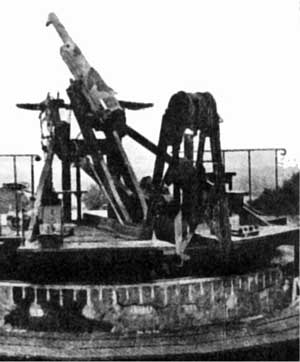
75mm gun on platform 1915
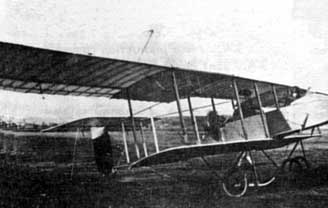
Farman 20 plane
Starting from the year 1917, the increasing performance aircraft in general and the ability of planes to fly at a high
![]()
altitude (over 3 000 meters) make the study and development of a gun with performance greater than those of 75mm gun (access to a ceiling above) and new materials (shooting at low altitude). Two projects of guns are leaded. The first produced by the workshops of Puteaux is an emergency response by placing on platform type Raguet a 105mm field gun model 1913. The second, conducted by the arsenal of Creusot, is a new material called « 105 G.P. Creusot-Arnouville » specially designed for anti-aircraft fire.
In early 1916, the draft machine gun from 25 to 30mm of Pagezy squadron leader had not been implemented, a 37mm automatic gun with explosives fusants shells is under consideration. But many technical problems prevented such
equipment to be in service at the time of the Armistice.
When the war ends, the anti-aircraft artillery comprises more than 900 guns, 470 machine guns, 400 projectors and 620 tethered balloons for protection.
THE METHODS
As for the material at the beginning of the conflict, the methods are first empirical and very sketchy. They are often inspired by those of field artillery. Thus, one of the first method is called the « squeezed », which closely resembles the « enclosing » gunfire on the ground. It is to draw up so-called « long » and a so-called « short » (the difference between these increases defining the extent of « squeezed »)
![]()
and then to a shot scattered in an area situated between this increases. With the gun on car, « the method of aim by outburst » is advocated. A first shot with shells fusant is fired with estimated elements of shooting. The gap between the point of outbursting and the aircraft is measured through the scope that can be shifted with the plane shooting. For the next shot, it introduced a correction equal to the gap. Wrong in principle, this method gives very poor results. It was quickly abandoned.
The turning point occurs late 1915 when the theories developed well before the war by the squadron leader Pagezy (54), then commander of the 506th regiment of colonial artillery, are transformed into « Provisional instruction on the organization and conduct firing of the 75mm gun against aerial targets » in December 1915.
To apply these methods, it is no longer possible to have disparate as the staff at the beginning of the war to serve the many materials preparation and execution of fire which improvements are continued continuously under the leadership of head squadron leader Pagezy.
Another officer, lieutenant Le Prieur (55) who had made before the war a firing machine for warships of the navy, adapts its methods to anti-aircraft fire directed and carries
out, in 1916, an anti-aircraft shooting conjugator (56)
With these research efforts, The training officers is performed at training centre of Arnouville. It remains to do the same with the soldiers especially as a shortage of the undermanned allocated to the antiaircraft artillery units a large number of injured or unfit for service at the front men. Two centres for education are created, one in Villers, and the other in Mitry-Mory.
The british artillery shot 341 and italian artillery, 129 for a total of more than 900 german planes shot down. Germany claimed the number of 750 shot down allied aircraft.
![]()
BETWEEN THE TWO WARS
BACK TO THE TIME OF PEACE
On January 25, 1919, it was decided that the army should revert to its pre-war levels. The defense against aircraft, which had emerged during the conflict, is the subject of a study prior to the decision of July 24, 1919.
A school of defense against aircraft, scheduled in Orleans, was finally established in Montargis with elements of the three centres of education and training of Arnouville, Pont-sur-Seine and Avord. A centralized establishment of defense against aircraft is divided between Chartres and Villefranche-sur-Cher.
The five newly formed regiments and course practice shooting against aerial targets of Montargis are attached to the service of Aeronautics. That is where a certain stagnation of the defense against plane during the period of euphoria immediately following the signing of the Treaty of Peace. The victorious France fate of a terrible conflict which has consumed a large portion of its energy and its forces. Also, nobody cares weapons studies and especially those on the anti-aircraft artillery. Everybody wants to believe that this conflict is the latest and postponed its hopes on the social progress that can bring new technologies such as aviation.
The civil aviation, which had improved sharply by the need to fight, will put this technology for old men dream : fly, fly faster, fly higher, day and night ...
![]()
Since 1920, the aviator Casale reached an altitude of 9.500 m, record broken in the same year by americans with 10.000 m.
Similarly in the area of speed, Sadi Lecointe reached 313 Km / h on January 20, 1920. This record is increased to 448 km / h in 1923 by Warrant officer Bonnet.
In front of such progress of the plane, no-one, civilian or military, finds necessary to combat hostile aircraft other than its own air force. This conviction is even greater in France that the defnse against plane is dependent of the aerospace and airmen that are still confident that the plane can only provide the defence.
For four years, the french artillery of defence against plane will vegetate. In 1922, General Pagezy and the team of precursors of the Great War finally came to make their voices heard.
THE STARTLE OF 1923
By decision of 25 August 1922, defence against plane is transferred to the Direction of artillery and reorganized in
October 1922.
The center is transferred from Montargis to Longeville-les-Metz and took the name College of defense against aircraft at the same time that a commission makes adopt a comprehensive programme of modernisation of means.
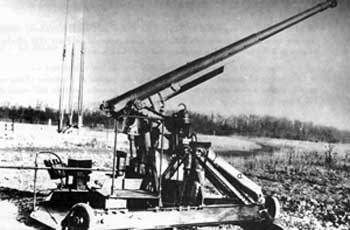
105mm experimental anti aircraft gun
![]()
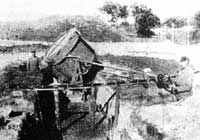
THE EVOLUTION OF THE EQUIPMENTS
The means for shooting
For example, the first open competition sees manufacturers to recuse themselves and the only stayed in contention going from one problem to another : outburst , too weak engine, and so on. Finally, in 1934, the studies (a 105mm gun on trailer and a 82mm gun on car) are abandoned.
That time wasted !
The heavy guns
In 1934, after the setbacks of studies on the calibers of 105mm and 82mm, the general staff turns to the business Schneider just have realize an excellent 90mm gun for the Navy. This caliber is chosen for the heavy gun.
![]()
In fever, that the approach of an inevitable conflict trigger in all areas, the excutionss speed up especially where the delay is more important.
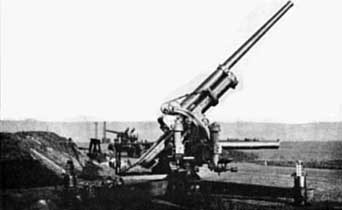
90mm gun model 1939
Beginning 1939, the 90mm gun C.A. Model 1939 S (57) is adopted. An order of 120 guns is placed. Only 7 guns will be delivered before the armistice in June 1940 and one or two of them are involved in the fighting of the campaign for France.
The average guns
So, for the anti aircraft main weapon in this calibre, we
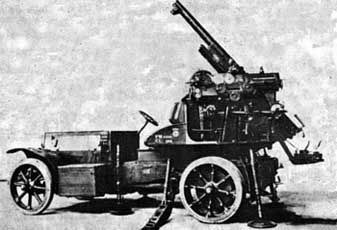
75mm gun on car model 1933
However, the former models (58) remain provided with the contribution of some progress in the shooting accessories.
Meanwhile, France is interested in a new swedish material, the 40mm Bofors, and adopt it under the name of 40mm gun C.A. (59) model 1938 with swedish corrector. Shortly thereafter, the business Modern Precision provides a
![]()
french corrector of its manufacture for this gun.
Only one gun of this type is delivered in May 1940.
The light guns
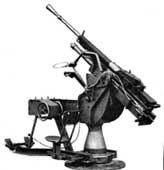
25mm single tube gun model 1940
The 13.2mm machine guns complement the panoply in this range.(60)
The means of behavior of firing
The effort launched in the early 30 intensifies in the area of indirect fire. The central shooting post model 1935 developed for the 75 mm gun is adapted to the balistic of the 90mm gun. It was adopted under the name central post to fire against plane, model 1940.
Experiments with magnetic detection are carried out following the discovery of these resources during a visit to a centre for experimentation of the Royal Air Force in 1929 but the exercises are based mainly on the lookout. A study of the means of electronic behavior of firing was initiated by the command communications in March 1939.
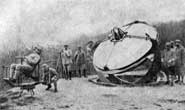
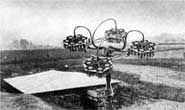
![]()

Cylinder abacus
![]()
Rise with abacus
![]()
Altitude Rangefinder
![]()
UNITS IN 1939-1940
The seven existing regiments in 1939 are divided into two brigades :
The 408th and 409th Anti Aircraft regiment planned to be established in October 1939 are not set up.
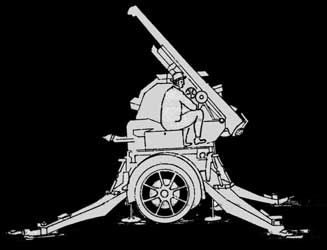
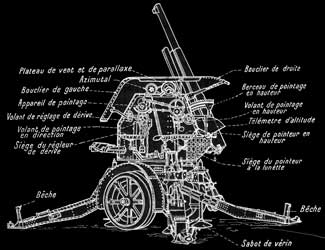
![]()
Tool born in the emergency in 1914, the anti-aircraft artillery was, in 1918, an operational tool that really works. As another subdivision of artillery also born during the Great War « trench artillery, infantry support », the Anti Aircraft units will suffer from the return to peace time, the damaging effects of demographic deficit, the inconsistency and incoherence of equipment programs, internal wars and the absence of doctrine as a result. An underestimation (unconsciously ?) capabilities of the enemy has exacerbated this material and moral situation.
In fact, while attached to the armed forces, the artillery regiments air defence are responsible for the mobilization of units of the Air Defence of the Territory (A.D.T.), who work with the fighter squadrons of the air force direction. In 1939, the shortage of staff in the artillery, in general, is around 30%. It is 40% in units of air defence. The system used to mobilize thus severely penalizes the air defence to armed (diversion for the benefit of the A.D.T. takes place in a reduction factor of 1 to 5, 1 active unit drift 5 units A.D.T.).
More importantly, during the first 15 years of the post-war period, in addition to numerous reorganizations, antiaircraft artillery gets little credit and suffered inconsistency
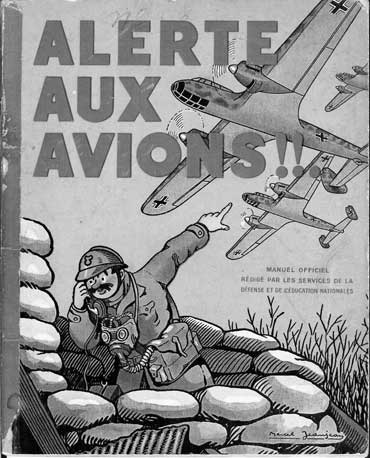
![]()
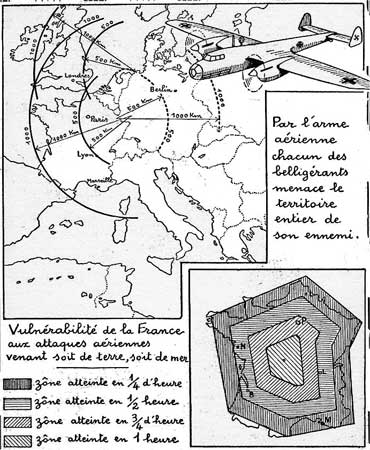
and incoherence of programmes. Only in the 30s that efforts are being made budget. Again, according to a principle unfortunately once again become highly topical (61), efforts are focused on the production of guns, principal organs of the mission, forgetting the « accessories » (shooting posts, telemetry, communications, ammunitions, ... ) whose importance is vital in this system where detection, preparedness are the other components of the tripod on which the success of the shooting and whose execution is the last component. It is also worth noting the huge disparity in the park (20 different models and sizes) and ammunitions (in the wide range fuses in particular) with the difficulties in training, equipping, maintenance and management that entails.
In addition, the internecine wars, especially the struggles for influence between the army and the young Air Force. As the latter feared that the army would confiscate his exclusive use A.D.T. units stationed in the war zone, there is no single command. For anti-aircraft artillery, coordination of fire and manoeuvre is a major headache. Everyone is going to make his war in his corner as shown in the diagrams of the Great War : Aviation will be, as in 1918, the eyes of the infantry, itself backed by artillery !
![]()
During the same time - between 1919 and 1939 - the threat, that is the aircraft, has doubled its capacity. The rate rose from 40m / s to about approximately 100m / s. The maximum altitude - ceiling - reached pass up from 3 000 to 6 000 m. These features make the aircraft beyond the reach of over 50% of the French anti-aircraft artillery. The consequences are known (62).
After the rearmament of ANFA in 1943, French anti-aircraft artillery found abilities of the early twentieth century. Since then, it will not cease to follow and, if possible, get ahead of the evolution of the threat. Thus, during the second half of the twentieth century, the commissioning of the jet in the air forces led anti-aircraft artillery specialist to use the missile as a vehicle of its ammunition, leaving use the anti-aircraft gun to the troops maneuvering for their self-defense. But that is another story !
Lieutenant-colonel (CR) Pierre SAINT-POL
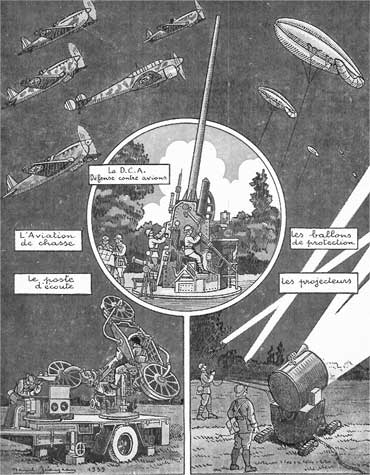
![]()
SOME DETAILS OF ANTI AIRCRAFT MATERIALS ON DUTY IN 1940
| Total weight | Shooting capacity | Length of the tube |
Initial speed | ||
| Horizontal | Vertical | ||||
| l3,2mm Machine gun design 30 | 360° | 880 m/s | |||
| 25mm design 38 | 1 100 kg | 360° | 5 à 78° | 900 m/s | |
| 25mm design 39 | 1 150 kg | 360° | 3 à 90° | 900 m/s | |
| Bofors 40mm gun | 2 500 kg | 360° | 5 à 90° | 2,40 m | 875 m/s |
| 75mm gun design 32 | 5 330 kg | 360° | 5 à 70° | 4 m | 700 m/s |
| 75mm gun design 17/34 | 4 800 kg | 360° | 0 à 63° | 4 m | 700 m/s |
| 90mm gun design 39 | 8 455 kg | 360° | 10 à 80° | 4,50 m | 820 m/s |
| Weight of cartridge |
Weight of shell |
Ceiling | Reach | Cadence shooting (strokes per minute) |
|
| Machine gun l3,2 design 30 | 450 | ||||
| 25mm gun design 38 | 0,700 kg | 0,250 kg | 2 500 m | 7 500 m | 250 |
| 25mm gun design 39 | 0,700 kg | 0,250 kg | 2 500 m | 7 500 m | 300 |
| Bofors 40mm gun | 2,120 kg | 0,890 kg | 1 500 m | 3 200 m | 120 |
| 75mm gun design 32 | 10 kg | 6,070 kg | 7 200 m | 13 000 m | 16 |
| 75mm gun design 17/34 | 10 kg | 6,070 kg | 7 200 m | 13 000 m | 16 |
| 90mm gun design 39 | 20 kg | 11,200 kg | 9 000 m | 17 450 m | 12 |
![]()
Pointing possibilities of the anti-aircraft equipment
Captain P. RENAUD, "Artillery Journal" 1935
« The anti aircraft materials (guns and pointing devices) must follow the targets with large angular velocity ; their pointing devices in azimuth and site must possess angular velocity sufficient to enable the pointing in satisfactory condition . The possibilities are not unlimited and there is always a certain portion of the area in which the fire is not possible, due to limitations of angular velocity (of materials). »
By a mathematical proof based on a linear velocity of the aircraft of 100 m/s (360km/h) and an altitude of 1 500m, the author shows that the constraints related to the technical parts and devices result in an impossible shooting zone with the following form :
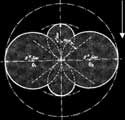 |
Direction approach of the aircraft |
Taking into account all possible directions of approach by rotating the "clover", the total dead volume is contained in a cylinder of 2.5 km in diameter ...
« We have seen here only dead volume in which the pointing is impossible as a result of the angular velocity permitted limited by the material. It should be noted that the lost plane at its entry into the dead volume must be taken at the exit by a maneovre similar to a designation of tqrget, resulting in a time-out difficult to quantify. »
« The anti aircraft intructions notice for the 75mm materials currently on duty a death cylinder l 000m radius. We saw earlier that the dead volume depends not only equipment but also on the plane. At present the rate of 50m/s (a basis for calculating the intruction) is largely out-of-date. »
« anti aircraft materials manufacturers must, if they want to avoid unacceptable limitations of the zone of action of their materials, calculating for this angular velocity of rotation in azimuth and site not allowing for aircraft speeds of 100m/s as volumes dead acceptable. »
![]()
Power of anti aircraft artillery.
Captain R. CHAUVIN, "Artillery Journal" 1938
In the particular case of the anti aircraft artillery, which is carrying out a shooting only prepared on small targets, the accuracy is a key to power. It is closely linked to the reduction of the vector of extrapolation.
The study of the power of the anti aircraft is a complex problem. We do envisage, in what follows, that from the point of view of the gun. The problem then arose in the following terms: How the effectiveness of the projectile, the size of the area of action and the reduction of vector of extrapolation do they depend of the caliber and the initial speed ?
a - Efficiency of projectile
The projectile is fired bursting forth. Its effectiveness has to measure the extent of the danger zone of shrapnels. In this case, it is a volume. It is, all things being equal, proportional to the cube of caliber. In the case of a shooting on land, the dangerous area of the same shell is measured by its surface beaten by shrapnels. It is only proportional to the square of size. By increasing the size of its equipment, anti aircraft artillery is a better deal than the ground gunner.
The initial speed does not appear to compromise the effectiveness of the projectile. If the increase in initial velocity projectile leads to a stronger (thicker walls therefore fewer chips) depletion of the atmosphere with altitude allows chips to travel greater distances.
b - Area of the working range of the material
If we shoot at the same initial speed two geometrically similar projectiles, it is known that their ballistic coefficients (coefficient, which reflects, among other things, the quality of penetration of the projectile into the air, it is more compact, more aerodynamic of projectile is great) are in inverse relationship of calibers.
![]()
The large-caliber projectile goes above and beyond ... It is therefore not very interesting to increase the initial speed of a small-calibre shells.
c - Reduction of extrapolation vector
The anti aircraft artillerymen know all the interest that focuses on reducing the extrapolation vector. (Indeed, the extrapolation vector is the distance flown during the plane target displacement time of the shell. Therefore, as in hunting rabbits to shoot " forward " of the target of a gap equal to the extrapolation vector. Increasing the initial speed reduces the time for " flying " and therefore, the extrapolation vector).
There is a need for high velocity with the smallest possible ballistic coefficient ... Again the large calibre is a source of profit for shooting average distances of 6 to 8 km. »
The author concludes as follows :
« You can admit, for example, that larger calibres are starting to :
It would be absurd to dismiss the anti-aircraft artillery in service; its effectiveness is appreciable and the artillery, according to the common expression, the vast deserves to exist. But it would be a grave mistake to consider Defense Against Aircraft artillery like artillery lightly. The antiaircraft artillery is heavy artillery. »

![]()